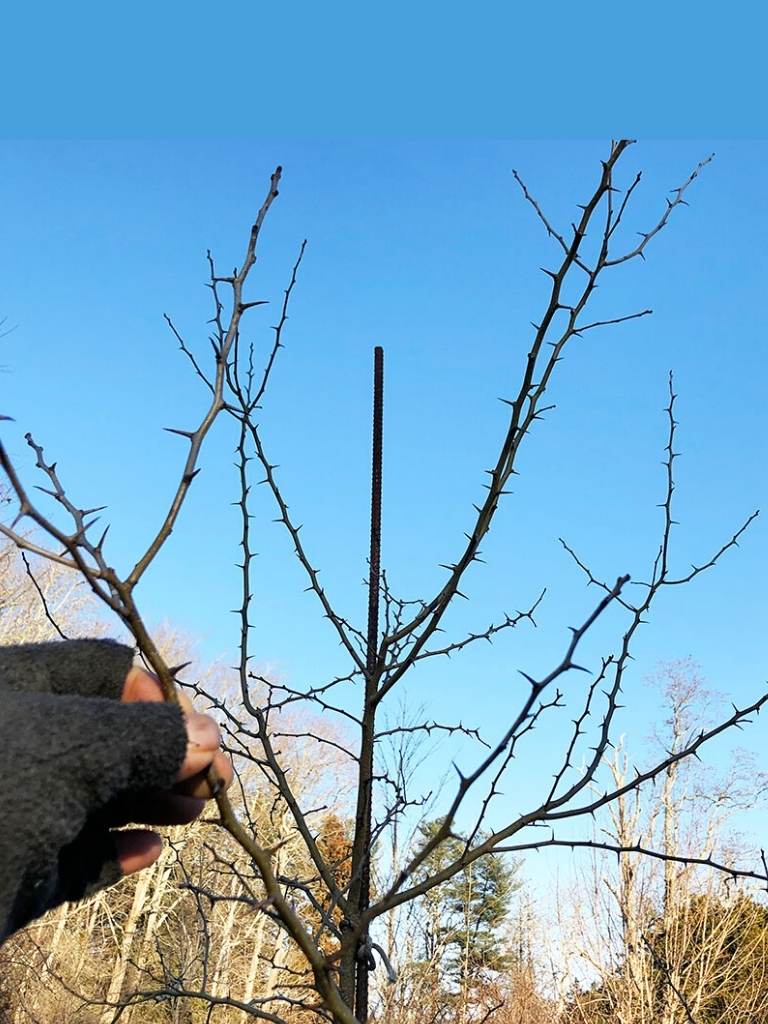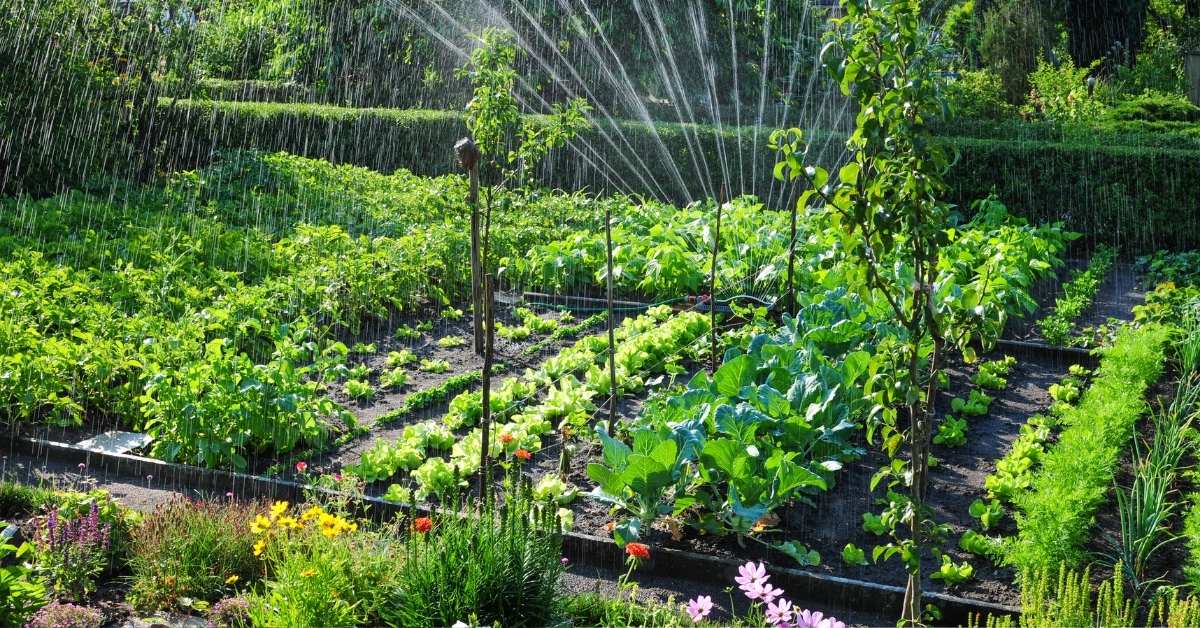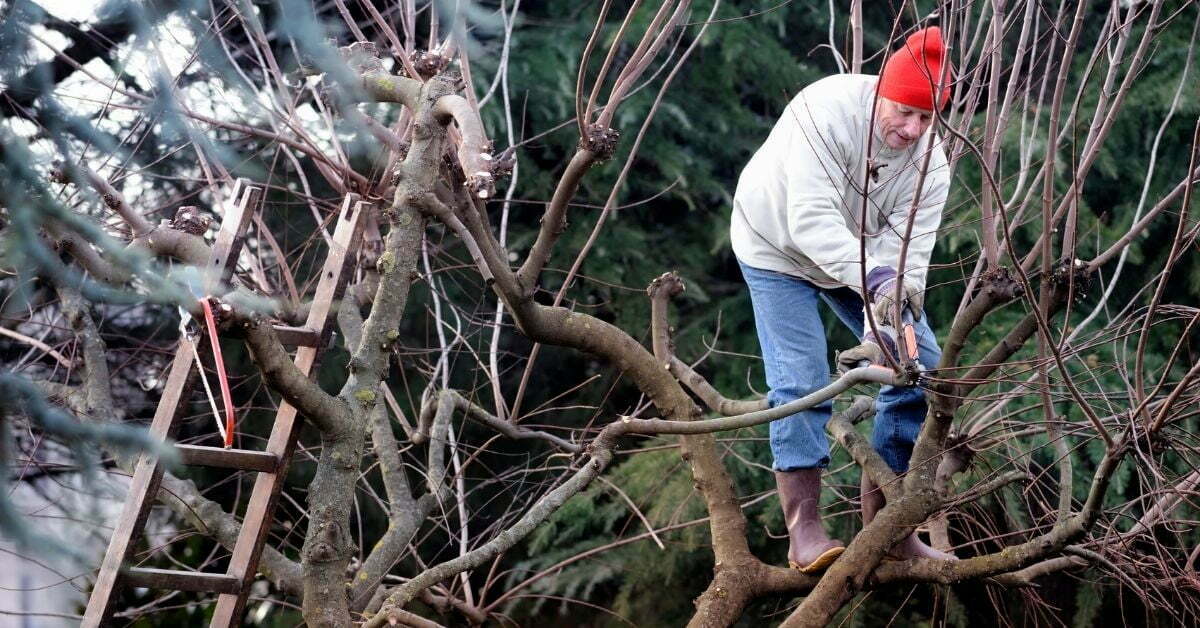I can’t seem to stay away from thorny, spiky, and prickly plants, not despite those painful features but because of them. Inch-long spines of osage orange are profuse as well as effective deterrents to casual contact with humans, let alone the nibbles of any and all browsers.
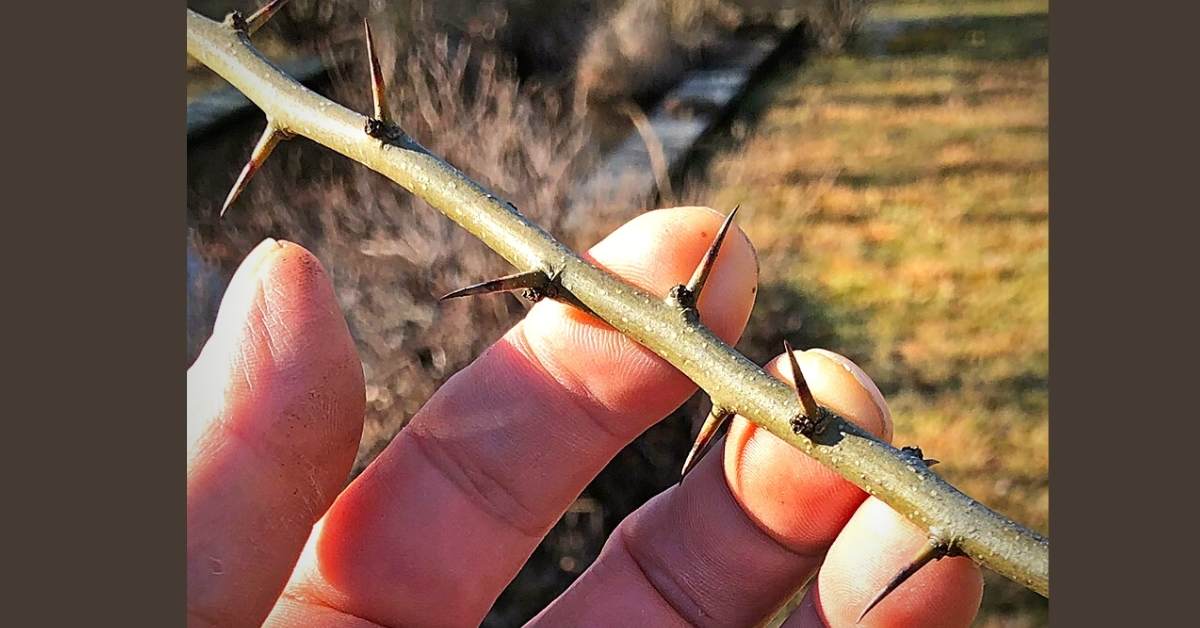
Here is a detailed guide on how to plant, grow and care for Osage Orange trees at home.
Compared to the stiletto five-inches of hardy orange, the six-inch branched destroyers of Caspian locust, or the countless rigid mega-spines of castor aralia, the well-spaced needles of osage orange are merely effective, not visually dramatic. But effective they are: No creature doesn’t give this eccentric tree a wide berth the piercing growth.
But thorny growth isn’t enough reason for me to have planted a quartet of Maclura pomifera as a bracket for the long reflecting pool, hundreds of feet from the house. It’s the record-setting fruits of this particular cultivar, Cannonball. They are reported to be as many as eight inches in diameter and weigh three pounds.
The largest of the Maclura quartet centers in the picture below. They are all too young—and too small—to make an impression when leafless.
Looking back to the house, that Maclura is at the center-left. Its smaller partner is barely visible at the center-right, while the nearer pair is out of frame at the front.
Imagine when these Osage oranges are somewhat more extensive and are also mature enough to bear their cannonball-sized fruits in a few years. If those remain on the branches after leaf-drop, they’ll be visible all the way from the house.
When they thud to the grass, the yellow-green monsters could still be visible. Heck, what is the potential fruit production of a quartet of Cannonballs? Perhaps showy on Google Earth?
As befitting most woodies in my garden—especially those with murderously sharp stems—Cannonball won’t be allowed to grow free-range. Instead, as these youngsters mature, they’ll be trained into standards twelve to sixteen feet high and eight to ten feet wide.
In a year or two, I’ll be able to implement the pruning that encourages the formation of dense, rounded, comparatively compact canopies. Then, it will become clear whether or not the winter display of leafless young growth is enhanced by bark that, inevitably, will be smoother than and not the same color as the mature bark of the permanent trunks immediately below.
Typical training techniques for Maclura don’t extend beyond forming the trees into hedges, which are dense and prickly enough to control livestock; the ornamental character of the young growth that results from maintenance pruning has never, to my knowledge, been remarked upon.
Stay tuned in years to come for updates on this cultivar’s developing charms: the results of the training, the displays of summer as well as fall foliage—and, of course, the astonishing cannonball-sized fruits.
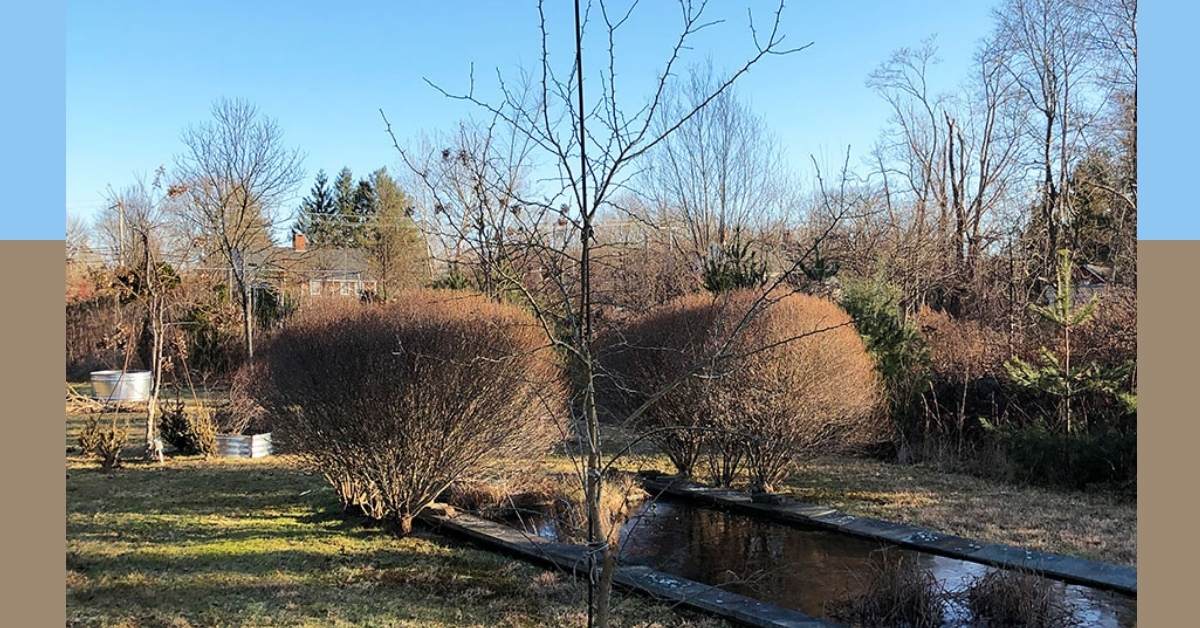
Here’s how to grow an Osage Orange tree:
Latin Name
Maclura pomifera ‘Cannonball.’
Common Name:
Osage orange, horse apple, hedge, or hedge apple tree): The tree’s native range (see below) overlaps that of the Osage Indian tribe, while the fruit’s size, pebbly surface texture, fragrance, and yellow coloring erroneously suggest that the species is a type of citrus.
Other common names derive from the unusual strength, rot-resistance, flexibility, and workability of the wood, which is excellent, e.g., for bows. French trappers named the wood bois d’arc—literally the wood for bows—which was anglicized to bodark. Still, other names derive from the unique fruit: hedge apple and horse apple.
Family
Moraceae, the Mulberry and Fig family.
What kind of plant is it?
Dioecious, deciduous, suckering tree.
Hardiness
Zones 4 to 9.
Habit
Free-range trees have a short trunk with a wide, rounded canopy. Young stems tend to be viciously spiny, as do younger trees. Unless trained, Maclura often matures with multiple trunks. It tends to sucker in response to the hard pruning needed to maintain trees as a hedge, forming uniquely impenetrable colonies thanks to the spines and the densely emerging stems.
Rate of Growth
Medium to fast. Ultimately forty to sixty feet when growing free-range.
Size in ten years:
Fifteen feet or more.
Texture
Dense when in leaf; twiggy when not.
Grown for;
its fruits: Even those of the straight species are unique: Grapefruit-sized and heavy, with a thick, pebbly, greenish-yellow, citrus-peel-like surface, plus a citrusy fragrance, they are dead ringers for true citrus until you break one open.
The interior is fleshy but not juicy—indeed, compared to true citrus, the interior of an osage “orange” seems to be all pith. Worse, the interior oozes a milky latex when crushed or cut. If the flowers were fertilized, seeds would be present; if not, fruit can still be formed but will be seedless.
Fruits of Cannonball are aptly named. They can be much larger than normal, weighing up to three pounds and twice the normal diameter. My trees aren’t mature enough to fruit, but pictures suggest that a Cannonball fruit can be eight inches across or larger; fruits of the straight species are typically three to five inches in diameter.
Its toughness: Maclura possesses a legendary combination of hardiness, durability, and longevity. It thrives in almost any combination of rich or deficient soil, extremes of heat and cold, and wetness or drought. Massive trees two centuries old are known.
its resistance to browsers: Because of its spiny stems and the sticky latex that oozes from disturbed wood, fruit, and foliage, Maclura is unpalatable to herbivores that would need to chew material before swallowing it. (Its fruits may well have been quite palatable to now-extinct megafauna, though, which could have swallowed them whole; see “Quirks,” below.)
Its spines, which are formed on juvenile stems. In circumstances that foster plenty of close-to-the-ground juvenile growth—as with a hedge—Maclura can form a barrier that is so impenetrable that it could be used not just to keep humans in check but also to keep cattle in check too.
Indeed, thousands of miles of Osage orange was planted in the midwest and prairie states as an animal-control barrier when the lumber for fencing was expensive or unavailable. The trees also function as a windbreak, which is another invaluable talent in such tree-poor areas.
Spines are formed by a given length of stem only once, during its first season of growth. Although the leaves are shed that fall, the spines persist for several seasons. Spines of rapidly-growing stems of Poncirus trifoliata—as are typically formed in response to the hard pruning needed to maintain that species as a hedge or topiary—are dramatically longer than slowly-growing stems.
Are the spines of Maclura similarly variable? I’m growing my quartet as giant standards that will require pruning so as not to expand into full-sized shade trees. So I’ll be able to determine if Maclura also displays the connection between sizes of spines and the extent of pruning.
Its tolerance of pruning and training: Maclura can be formed into dense—indeed, impenetrable—hedges that can be maintained at almost any degree of informality and yet still function as barriers.
The trees are reported as suckering vigorously; this might be even more pronounced when Maclura is grown as a hedge because the regular pruning would diminish the apical dominance of upper growth and enable dormant growth buds to activate even from the roots.
Its ease of establishment: Maclura transplants readily and germinates so easily from seed that thousands of miles of hedgerows of it were established across the Midwest before the advent of barbed wire.
Its strong, flexible, resistant wood: Maclura wood contains toxic chemicals to a number of fungi, so when made into fenceposts (or any other use that involves direct ground contact), it is strikingly rot-resistant.
The wood is strong enough yet flexible enough—and workable enough—to be superlative for wood bows. The wood’s strength also makes the trees unusually resistant to heavy ice, snow, or high wind damage.

Flowering season for Osage orange Tree
Late spring, appearing at the base of newly-mature foliage and, so, not showy. The flowers’ muted coloring works against showiness, too: Female flowers are greenish and arrayed in tight spherical heads, whereas male flowers are light brown, arrayed in pendulous catkins.
My trees are still too young to flower, so I haven’t been able to determine if flowering occurs on first-year growth or (more likely) on growth formed the previous year. If the latter case is true, the flowers will be all the more fully hidden.
Fruiting season
The unique fruits display their best color in September and fall to the ground in October. October, then, is the month for their striking potential for messiness and even damage as they pound down onto anything below. In this regard, osage orange is the hardy version of coconut, whose heavy fruits can be damaging or even fatal when they plummet.
Color combinations
The green foliage of Maclura goes with everything, as does the fruit, whose greenish-yellow color doesn’t emerge until late summer or fall; even so, its late-season hue isn’t strong enough to clash with pink and rose. Cracks in mature bark reveal an orange underlayer; occasionally, a larger section of outer bark isn’t present, exposing the orange underlayer more substantially.
Because of the dense foliage, the bark usually is only (modestly) showy in the winter when, in any event, almost any colors, in any combinations, would be welcome.
Partner plants
The quirky, specific characteristics of Maclura strongly inform your choices for nearby planting. The foliage canopy of free-range trees is dense, so the ground beneath Maclura is shaded. The root system is deep and wide-spreading, making nearby planting possible as long as the companions are shade-tolerant.
The remarkably large fruits are heavy and solid enough to injure fragile or large-foliaged underplantings—let alone vehicles or pedestrians—as they fall. In addition, the fruits could roll or even bounce some distance if they land on hardscape or mown grass, creating further hazards for vehicles as well as pedestrians and wide-spread challenges with cleanup if they become crushed.
Further, although self-seeding isn’t inevitable, it might be so successful in a given garden that regular retrieval of fallen fruit would need to be a priority.
These practical considerations suggest that Maclura is not the tree to partner with detailed underplantings. Not least, those underplantings will, more than likely, need to permit substantial access by foot for fallen-fruit retrieval—plus can’t be damaged by the impact of the fruits’ descents, nor smothered as fallen fruits remain in place for days or more awaiting your next round of retrieval.
Nor can those underplantings be so bulky that fallen fruits would be hidden in their growth or inaccessible if the growth were woody or twiggy.
All in all, clumping, medium-to-short, shade-tolerant ornamental grasses (or grass-like perennials) seem best. If planted far enough apart, there would always be bits of free space between them for you to review the “fruit fall zone” foot by foot.
And their flexible foliage and stems are unlikely to be injured even by a direct hit. There might even be a striking visual created if fallen fruits array themselves randomly amid what could be an orderly grid of grassy clumps.
Maclura‘s tolerance of moisture, as well as drought, affirms the root system’s description as being deep and wide-spreading.
Thus, the premium choices for a grassy, clumping, fruit-tolerance, accessible, grid-creating, photogenic groundcover would be variegated forms of Hakonechlora macro or Liriope muscari. Liriope spicata is a possibility as well, in that its wide-spreading growth is so dense that fallen fruits are likely to rest largely atop it—and attractively so—while the occasional foot traffic to retrieve them would be fully tolerated.
If the chosen site were moister than usual, forms of Carex would likely thrive. Clumping cultivars of Carex morrowii remain a foot high or less, and some, like Ice Dance and Silver Sceptre, are variegated as well. The juxtaposition of the prehistoric, green-yellow fruit amid the clumps of their narrow striped foliage would be striking, indeed.
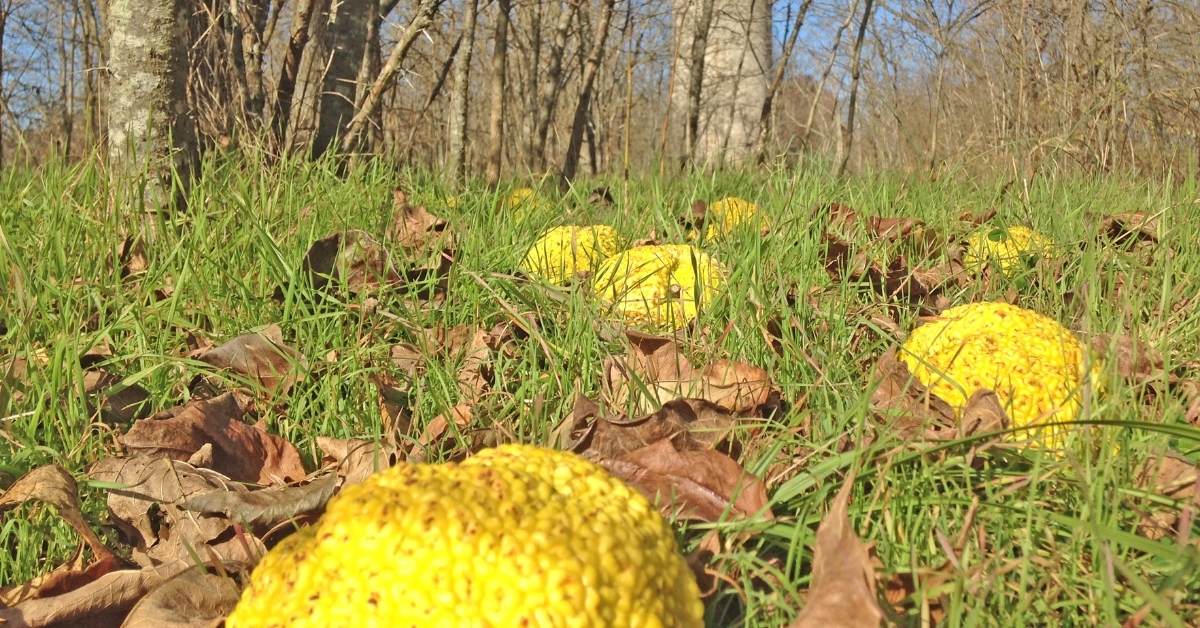
Where to use Maclura trees in your garden?
Maclura grows best in full sun; shaded growth drops its foliage if the shade is too deep. Ideally, then, site Maclura away from buildings and where it is the tallest tree in its vicinity.
The fruits present their own cautions: Never site Maclura near buildings such that falling fruit could become trapped by gutters, fall down chimneys, or land on any paving or delicate surfaces where it could trip pedestrians or damage, say, that patio umbrella’s canopy.
If possible, never sit amid grass that must be mown during the October “fruit fall” season, unless you are up for clearing the fruits away before each cut, as well as wearing a hardhat while at work.
Similarly, avoid sitting amid Maclura grass that attracts pedestrians during the fruit-fall season, lest they be inconvenienced, grossed out by smashed, slippery, smelly fruits, or even injured by being struck by one as it falls, or slipping one when it’s on the ground.
To avoid all of these problems, either plant Maclura in a sunny, grassy area where pedestrian access can be controlled by fencing, or that is remote enough that it’s their own damned fault if they venture under the Maclura. Or include the tree in a planting expansive enough to capture the fallen fruit, composed of rough-and-ready underplantings that the falling fruit wouldn’t damage.
Seeding
Yet another consideration is the potential for self-seeding: The underplanting then needs to be accessible by foot so that you, the diligent gardener, can collect the fallen fruit before its seeds are dispersed. Remember that squirrels are frequently reported as loving the seeds; most of the time, you’d want to get to the fallen fruit before they do. See “Plant partners” above.
Other options include growing Maclura at the reduced overall size and, so, reduce the area impacted by fruit fall, let alone the number of fruits themselves. The classic choice is as a hedge, whereby the full-to-the-ground growth can trap much of the fruit and retain it.
(Conveniently, if seeds that will inevitably be trapped within the impenetrable growth germinate, they’ll only add further density to it.) Another option is to grow Maclura as a standard, whose comparatively diminutive height and spread will reduce the fruit-fall zone accordingly.
Either option would also make the prophylactic harvest of the fruits more practical while they are on the tree. Maclura trained in either fashion is compact enough with few enough and controllable enough fruits to be suitable for a small-scale sunny garden. See the second “How to handle it” box below.
Clearly, a free-range, fruit-bearing Maclura—the female, in other words—is not appropriate either for most public contexts or most private gardens. In striking contrast, the male forms, which are inherently fruitless, are almost ideal for both public and private uses because the species is so tolerant of challenging conditions. See “Culture” below.
The only caution with the males is, reportedly, that their spent flowers can become smelly as they accumulate beneath the tree. Given the male’s striking range of positives—especially with the current thornless cultivars (see “Variants,” below), a one-time cleanup of the spent flowers is an alone and minor hassle.
Culture
Despite the generous circumstances of its native range (see below), Maclura is remarkably tolerant of—even oblivious to—far more challenging conditions. It thrives where almost nothing else will, tolerating full sun to part shade in almost any soil: compacted or loose, moisture-retentive or lean and dry, rich or poor in nutrients, high or low pH.
How to handle Maclura pomifera: The Basics
Plant it in a container or B&B material at almost any time year-round that the soil is workable and that sufficient water for establishment can be provided. Transplant at practically any time falls into early spring that the tree is still leafless.
If your chosen site has enough room, free-range Maclura doesn’t need formative pruning to adopt its characteristic short-trunked, broad-canopied mature form. Its strong and flexible wood makes it unlikely to need maintenance pruning (after a rough winter, say) either. If suckers appear, cut them off whenever convenient.
Ongoingly, the chief task is late in the season, when fruit-fall happens. Collect the fruits as soon as possible—hopefully, before any become smashed and sticky—and compost them. Wear protective headgear when working under the tree during the fruit-fall season if the fruits have seeds, only compost where your procedures ensure hot enough composting to kill the seeds.
If the insufficient temperature is a concern, you could dispose of the fruits somewhere in deep shade, where this sun-requiring species’ seedlings are unlikely to persist.
How to handle it: Another option—or two?
Maclura responds so well and so quickly to pruning and is so easy to grow from seed that fiercely-spiny, impenetrable, mean-weather-oblivious hedgerows of it were the solution in the Midwest and Great Plains before the invention of barbed wire soon after the Civil War.
Now that fenceposts, barbed wire, and chain links are available coast-to-coast at any Home Depot, you’re unlikely to need to create a Maclura hedge, but you still can.
My training goal for my quartet of Cannonballs is that they are trained to extensive standards. Doing that is straightforward in terms of the woody growth itself:
Stake young trees as needed to get a straight trunk as high as required—I’d say eight feet—then lightly prune growth higher than that whenever convenient from late fall through early spring to encourage the formation of a compact and balanced canopy.
If side branches emerge lower down on the trunk, cut those off whenever convenient; if suckers emerge from the base or the roots, ditto.
The question with forming a standard of any Maclura cultivar whose fruiting is desirable, as is the only reason to grow Cannonball, is how the pruning needed to form the compact canopy can still occur without impeding the formation of flowers and fruit. The first year of growth of such trees is almost never mature enough to flower and fruit.
(As I’ve proved to my frustration, with my pollard of gold scots elm, even growth that has been allowed to grow freely for three years after pollarding may still not be mature enough.) If there are too many years between pollards, the Maclura canopy may grow too large for the given space. My hope is that stems of Cannonball that form in response to pollarding can mature to flowering by their third season.
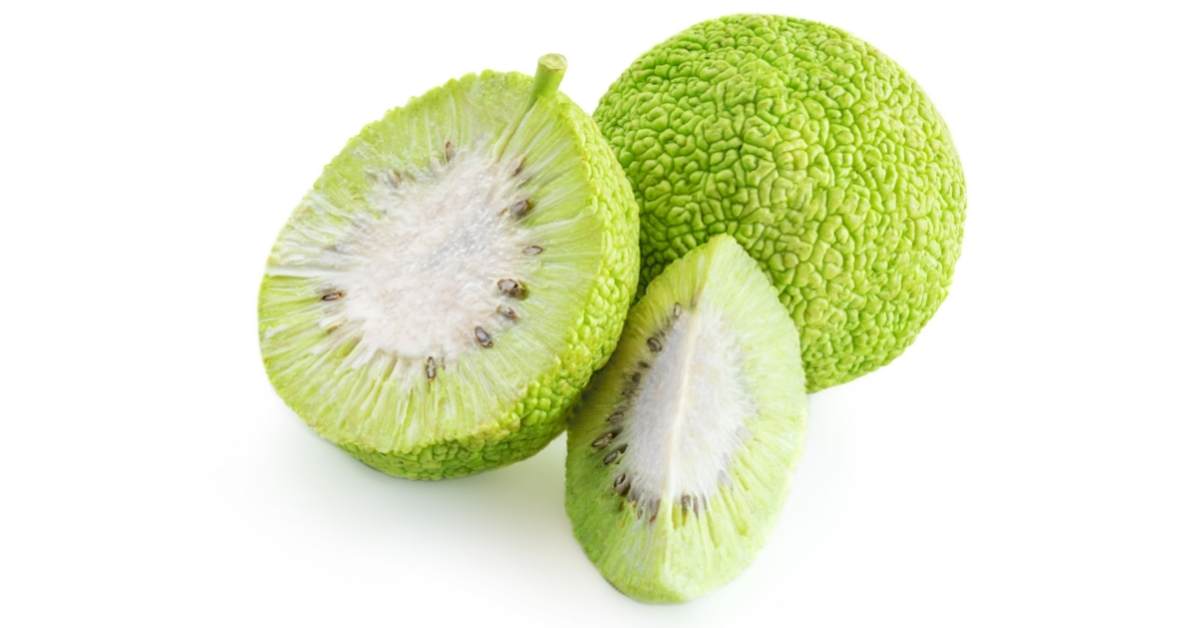
Quirks and special cases
The female flowers can mature to fruit even without fertilization, although the fruits will be seedless. If self-seeding is a concern, it can be prevented by planting only male or only female trees.
Because male trees are fruitless, they are preferable in that they preclude the possibly serious liability issues, let alone maintenance challenges, of the heavy, messy fruit, whether seedless or not.
The species’ comparatively small region of the current nativity—three states in south-central North America—should be a puzzle given that the tree is hardy over most of the continent and is strikingly flexible about soil moisture or clay content ambient heat, and pH.
There’s some sort of connection with fruit’s being enormous, heavy, and not-normally-edible, qualities that don’t foster wide distribution on their own. But current herbivores don’t find them palatable, either, and none would be large enough to swallow them whole.
Archeological evidence that predates the last ice age shows Maclura as far north as Minnesota—meaning that the species was established that far north then but was driven south to its current natal habitat by the ice age.
One satisfying hypothesis why the species didn’t re-establish northward is that mankind inadvertently put a stop to such widening distribution of Maclura by killing off the continent’s megafauna—mastodons, giant beavers, and giant sloths—after migrating to North America from Asia about 13,000 years ago.
Another hypothesis is that the large comet that also struck North America then helped bring on a 1,300-year cold snap known as the Younger Dryas and that the cold snap (think ice age) did in the megafauna. A third hypothesis focuses just on the ice age.
However the extinction occurred, it’s appealing to surmise that any of these megafaunas could have swallowed the osage “oranges” whole and, so, avoided tasting the sticky sap—and that, with their extinction, a wider distribution of the species would have been stymied.
Distribution may well still extend locally in that the seeds themselves are edible and are favored by squirrels. But squirrels are neither migratory nor wide-ranging in their home territory, so they would not likely distribute seeds farther than a hundred yards or so.
Downsides of Osage Oranges
The strikingly large fruits create significant litter when they fall; they could also create a legal hazard, in that they are heavy enough to potentially damage anything parked beneath them—or injure humans who may be foolish enough to enjoy Maclura shade during their fruiting season.
Maclura grows large enough to function as a shade tree and is tough enough to thrive in the typical heat, compacted infertile soil, and drought faced by street trees. The females would be disasters in such a setting, what with their large, sticky-juiced fruit thudding down onto parks cars and being crushed by traffic.
Maclura can self-seed to the point of invasiveness, so don’t plant any form of male Maclura in the neighborhood of Cannonball, lest the Cannonball fruits contain viable seeds. See also “Quirks” above.
Although male trees don’t produce fruit, their released flowers are reported to be messy on the ground, creating an unpleasant order if they are allowed to rot in place.
See “Where to use it” for options where both sexes of this tree can be at their best.
Variants
Along with Ginkgo, Maclura is a rare hardy fruiting tree where the pressure in hybridization and discovery of mutations is for cultivars with little or no fruit. (At least Ginkgo seeds are edible by humans, which makes the smelly, slippery fruit that surrounds them bearable as long the trees aren’t used as street trees.)
Cannonball, then, is some sort of apotheosis of useless grandiosity: Nothing useful about the fruit is enhanced by the striking size other than the weird visual of that striking size.
The “variant hunger,” so to speak, has been for cultivars that are fruitless as well as spineless. The species’ singular combination of glossy foliage, deep hardiness, tolerance of weather that can be brutal summer as well as winter, seeming immunity from bugs and diseases, and lack of appeal to browsers are, in themselves, fantastically desirable.
Male cultivars are automatically fruitless, so the quest for fewer spines was the remaining hurdle. White Shield and Wichita are the current gold standards of spineless males, with White Shield being more available.
I look forward to spec’ing it for projects.
Availability
Online.
Propagation
Cannonball can be propagated by cuttings as well as grafting. Seeds are not likely to come true.
Native habitat
Since the last ice age, the native habitat of Maclura pomifera has been restricted to deep, moisture-retentive, bottomland soil in portions of Oklahoma, Arkansas, and Texas that were south of the extent of ice flow. Before that, evidence suggests that Maclura had northward distribution as far as Minnesota. What might have happened? See “Quirks” above.
